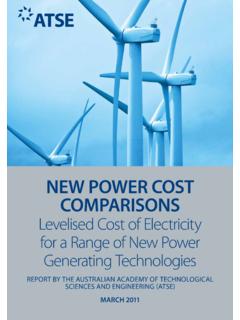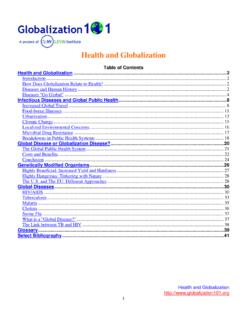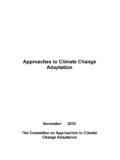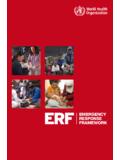Transcription of Climate Change impaCts on australia
1 6 Climate Change impaCts on australiaKey points This chapter provides a sample of conclusions from detailed studies of Australian impaCts . These studies are available in full on the Review s in emissions is expected to have a severe and costly impact on agriculture, infrastructure, biodiversity and ecosystems in will also be flow-on effects from the adverse impact of Climate Change on australia s neighbours in the Pacific and impaCts would be significantly reduced with ambitious global mitigation. The hot and dry ends of the probability distributions, with a 10 per cent chance of realisation, would be profoundly chapter focuses on australia s exposure and sensitivity to Climate Change and considers the impaCts of Climate Change on australia in six key sectors and areas, chosen either because they make a large economic contribution to australia , or because the impaCts on market or non-market values are expected to be pronounced.
2 These areas, sectors and subsectors are presented in Table Review considers both the direct (section ) and indirect (section ) impaCts of Climate Change on australia . Direct refers to those impaCts that are experienced within australia s land and maritime boundaries. Indirect refers to impaCts experienced in other countries with consequences for australia . The first focus is on the medians of the probability distributions of the impaCts identified by the main Climate models. For some sectors the middle-of-the-road assessment is supplemented with analysis of the higher ends of the probability distribution of impaCts .
3 The standard IPCC projections, and those based on them, provide cases that correspond most closely to those we expect from no mitigation or from effective global mitigation policies (Table ). The more serious implications of The Garnaut Climate Change Review122climatic tipping points are not examined, due to the rapidly developing nature of the relevant science and the limited time available to the Review. Two time periods are discussed. The first is up to 2030. impaCts over the next two decades can be considered to be locked in because of past and present greenhouse gas emissions. The magnitude of these impaCts can only be tempered by our adaptation effort.
4 The second is the period from 2030 to the close of the century. The magnitude of impaCts on australia in 2100 will be determined by international greenhouse gas mitigation and also by australia s continued adaptation chapter offers an illustrative selection rather than a complete assessment of the impaCts that are likely to be experienced across australia . It reflects the insights provided in a series of papers commissioned by the Review, which are available on the Review s website. In addition to the sectors and impaCts discussed in this chapter, the papers cover livestock, horticulture, viticulture, forestry, australia s World Heritage properties, tourism in the south-west of Western australia , the Ross River and dengue viruses, ports, roads and telecommunications.
5 These studies are an important part of the base from which the modelling of economic impaCts on australia has been Review encourages readers to examine the commissioned studies. It has drawn on Australian experts in 30 fields of inquiry (listed in Table ) to provide a wide-ranging collection of analyses of impaCts . Further details on potential impaCts can be found in various synthesis reports (CSIRO & BoM 2007; IPCC 2007; PMSEIC 2007; Pittock 2003; Preston & Jones 2006).Table Sectors and areas considered in this chapterSector or areaDiscussed in this chapterModelled by the ReviewResource-based industries and communitiesSubsector or areaDryland croppingYes wheatYesIrrigated cropping Yes in the Murray- Darling BasinYes nationallyLivestock carrying capacityNoYesFisheries and aquacultureNoNoForestryNoNoMiningNoNoHor ticultureNoNoViticulture and the wine industryNoNoAustralia s World Heritage properties NoNoAlpine zone of south-east AustraliaYesNoSouth-west Western AustraliaNoNoCLIMATE Change impaCts ON AuSTRALIA6123 Table Sectors and areas considered in this chapter (continued)
6 Sector or areaDiscussed in this chapterModelled by the ReviewGreat Barrier ReefYesNoCritical infrastructureSubsector or areaBuildings in coastal settlementsYesYesurban water supplyYesYesElectricity transmission and distribution networkNoYesPort operationsNoYesRoads and bridgesNoNoTelecommunicationsNoNoCyclone impaCts on dwellingsNoYesHuman healthSubsector or areaTemperature-related death and serious illnessYes deathYesRoss River virus NoNoDengue virusNoYesBacterial gastroenteritisNoYesHealth of remote northern Australian Indigenous communitiesNoNoRural mental health NoNoEcosystems and biodiversitySubsector or areaA range of ecosystems and impaCts on plants and animalsYesNoChanges in demand and terms of tradeYesYesGeopolitical stabilitySubsector or areaGeopolitical instability in the Asia Pacific region and the subsequent aid and national security response from AustraliaYesNoCatastrophic events as affect AustraliaYesNoSevere weather events in AustraliaYesNoThe Garnaut Climate Change Review124To illustrate the impaCts of Climate Change out to 2100, the Review considered a set of physically plausible Climate outcomes for australia .
7 As shown in Table Table Climate cases considered by the ReviewCaseEmissions Climate sensitivityRainfall and relative humidity (surface)Temperature (surface) Mean global warming in 2100 Unmitigated 1 Hot, dryA1FI path3 C10th percentile90th percentile~ CUnmitigated 2 Best estimate (median)50th percentile50th percentileUnmitigated 3 Warm, wet90th percentile550 mitigationDryCO2-e stabilised at 550 ppm by 2100 (CO2 500 ppm)10th percentile90th percentile~2 C550 mitigation 2 Best estimate (median) 50th percentile50th percentile550 mitigation 3 Wet90th percentile450 mitigationBest estimate (median)CO2-e stabilised at 450 ppm by 2100 (CO2 420 ppm)50th percentile~ CNote: For each of the above cases global mean temperature is presented from a 1990 baseline.
8 To convert to a pre-industrial baseline add Understanding australia s vulnerability to Climate changeThe effect of Climate Change on the Australian population and natural assets will depend on exposure to changes in the Climate system, sensitivity to those exposures and the capacity to adapt to the changes to which we are sensitive. These components of vulnerability to Climate Change are illustrated in Figure s level of exposure and sensitivity to the impaCts of Climate Change is high. The extent to which these impaCts are realised will depend on the success and timing of global greenhouse gas mitigation and on national adaptation a nation, australia has a high level of capacity to plan for and respond to the impaCts of Climate Change that is, its adaptation potential is high.
9 The consideration of impaCts in this chapter assumes some adaptation at the level of an individual or firm. Climate Change impaCts ON AuSTRALIA6125 Figure Vulnerability and its componentsVULNERABILITYEXPOSURESENSITIVI TYA daptive capacityPotential australia without global mitigationIf global development continues without effective mitigation, the mainstream science tells us that the impaCts of Climate Change on australia are likely to be severe. For the next two decades or so, the major impaCts of Climate Change are likely to include stressed urban water supply and the effects of changes in temperature and water availability on agriculture.
10 All major cities and many regional centres are already feeling the strain of declining rainfall and runoff into streams. Most major cities are beginning to develop high-cost infrastructure for new water sources. In the absence of effective global mitigation, continued investment in expensive new sources of water is likely to be a mid-century, there would be major declines in agricultural production across much of the country. Irrigated agriculture in the Murray-Darling Basin would be likely to lose half of its annual output. This would lead to changes in our capacity to export food and a growing reliance on food imports, with associated shifts from export parity to import parity no-mitigation case is likely also to see, by mid-century, the effective destruction of the Great Barrier Reef and other reef systems such as Ningaloo.








